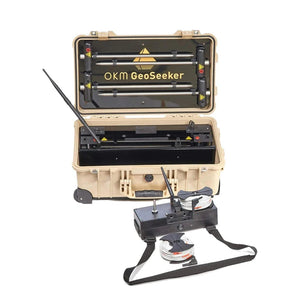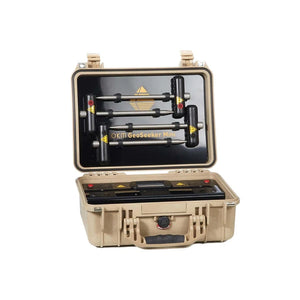Un detector de metales GPR , más precisamente llamado radar de penetración terrestre (GPR) , es diferente de un detector de metales tradicional en varios aspectos. A continuación, se detallan las principales diferencias:
Tecnología:
- Detectores de metales tradicionales: Estos dispositivos utilizan la inducción electromagnética para detectar la presencia de objetos metálicos. Transmiten un campo electromagnético de baja frecuencia y luego detectan la distorsión causada por los objetos metálicos cercanos.
- Radiofaro de superficie: Estos dispositivos utilizan pulsos de radar para mapear el subsuelo. Transmiten breves ráfagas de energía electromagnética al suelo y luego analizan las señales reflejadas para crear una imagen de lo que está enterrado debajo.
Detección de objetivos:
- Detectores de metales tradicionales: Estos dispositivos sólo pueden detectar objetos metálicos. No pueden distinguir entre distintos tipos de metales ni determinar el tamaño o la forma del objeto.
- Radiofaro de superficie: Estos dispositivos pueden detectar una variedad de objetos, incluidos metales, plásticos, hormigón e incluso huecos en el suelo. También pueden proporcionar una estimación del tamaño y la forma del objeto.
Profundidad de detección:
- Detectores de metales tradicionales: La profundidad de detección varía según el modelo y el tamaño y tipo de objeto metálico. Generalmente pueden detectar objetos enterrados hasta varios pies de profundidad.
- Radiofaro de superficie: Los GPR pueden detectar objetos enterrados a mucha más profundidad que los detectores de metales tradicionales. En condiciones ideales, pueden detectar objetos enterrados a decenas de metros de profundidad.
Aplicaciones:
- Detectores de metales tradicionales: Estos dispositivos son de uso común entre aficionados para encontrar monedas, joyas y otros objetos metálicos. También los utilizan los agentes de seguridad y las fuerzas del orden para detectar armas y otros artículos de contrabando.
- Radiofaro de superficie: Estos dispositivos tienen una gama más amplia de aplicaciones. Los utilizan los arqueólogos para localizar estructuras y artefactos enterrados, los ingenieros para inspeccionar los servicios públicos y la infraestructura subterránea, los geólogos para cartografiar el subsuelo y los científicos ambientales para localizar contaminantes enterrados.
A continuación se muestra una tabla que resume las diferencias clave:
| Característica | Detector de metales tradicional | Radiofaro de superficie |
|---|---|---|
| Tecnología | Inducción electromagnética | Radar de penetración terrestre |
| Detección de objetivos | Solo metal | Varios materiales |
| Profundidad de detección | Hasta unos pocos pies | Decenas de metros |
| Aplicaciones | Aficionados, fuerzas del orden, seguridad. | Arqueología, ingeniería, geología, ciencias ambientales. |
Por lo tanto, un GPR no es técnicamente un detector de metales, aunque puede utilizarse para localizar objetos metálicos. Es una herramienta más versátil y potente que puede utilizarse para una variedad de aplicaciones.
Los detectores de metales OKM se han ganado la reputación de producir GPR (radar de penetración terrestre) de alta calidad por varias razones clave:
1. Ingeniería y experiencia alemanas: OKM es una empresa alemana con más de 25 años de experiencia en el desarrollo y fabricación de detectores de metales y sistemas GPR. Su compromiso con los estándares de ingeniería alemanes garantiza componentes de alta calidad, un ensamblaje meticuloso y pruebas rigurosas. Esto da como resultado instrumentos confiables y duraderos diseñados para soportar condiciones de campo exigentes.
2. Innovación y tecnología avanzada: OKM invierte constantemente en investigación y desarrollo, ampliando los límites de la tecnología GPR. Incorpora funciones de vanguardia como GPR multifrecuencia, software de visualización 3D y algoritmos avanzados de procesamiento de señales para mejorar el rendimiento de detección y brindar información detallada sobre objetos enterrados.
3. Facilidad de uso: OKM se esfuerza por hacer que sus sistemas GPR sean accesibles para usuarios de todos los niveles. Diseñan sus dispositivos con interfaces intuitivas, software fácil de usar y materiales de capacitación completos. Esto garantiza que cualquier persona, incluso con experiencia limitada, pueda aprender rápidamente a operar un sistema GPR de OKM y lograr resultados óptimos.
4. Soluciones específicas para cada aplicación: OKM ofrece una amplia gama de sistemas GPR diseñados para aplicaciones específicas. Ya sea que usted sea un arqueólogo que busca ruinas enterradas, un localizador de servicios públicos que mapea infraestructuras subterráneas o un cazador de tesoros que busca objetos de valor ocultos, OKM tiene un sistema GPR diseñado para satisfacer sus necesidades específicas y maximizar su éxito.
5. Excelente atención al cliente: OKM ofrece una excelente atención al cliente para garantizar que los usuarios tengan una experiencia positiva con sus productos. Ofrecen soporte técnico, recursos de capacitación y actualizaciones de software constantes para ayudar a los usuarios a aprovechar al máximo sus sistemas GPR.
A continuación se muestran algunos ejemplos específicos de cómo el compromiso de OKM con estos factores se traduce en detectores GPR de alta calidad:
- OKM Gepard GPR: Este sistema cuenta con una potente unidad de radar con una amplia gama de frecuencias, lo que permite una penetración profunda y la detección de diversos objetos. El software de visualización 3D incluido proporciona imágenes detalladas del subsuelo, lo que ayuda a una interpretación precisa y a la identificación de objetivos.
- OKM Rover C4: Este sistema GPR portátil y liviano es ideal para estudios de campo y exploración arqueológica. Su interfaz fácil de usar y su software intuitivo lo hacen fácil de operar, incluso en condiciones de campo difíciles.
- OKM Fusion: este avanzado sistema GPR combina la tecnología GPR con capacidades de detección de metales, lo que ofrece una versatilidad y una información de objetivos incomparables. Es una herramienta poderosa para buscadores de tesoros, arqueólogos y topógrafos profesionales que buscan la máxima profundidad de detección e identificación de objetos.
En general, el compromiso de OKM con la ingeniería alemana, la innovación, la facilidad de uso, las soluciones específicas para cada aplicación y la excelente atención al cliente le han ganado una reputación de producir detectores de metales GPR de alta calidad. Estos factores contribuyen a su éxito en el suministro de instrumentos confiables, robustos y versátiles que satisfacen las diversas necesidades de una amplia gama de usuarios.






Dejar un comentario